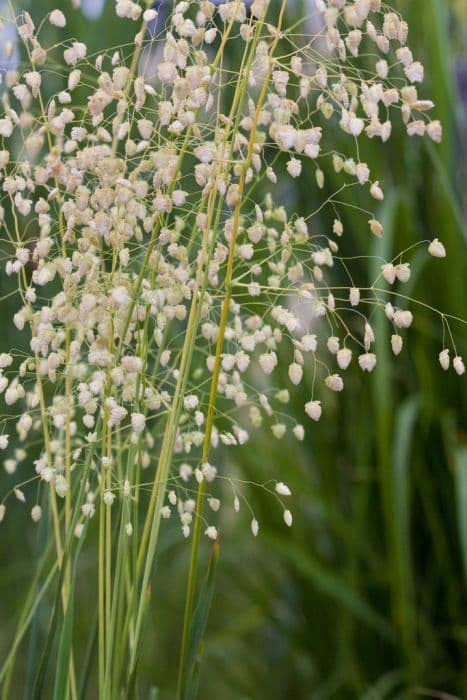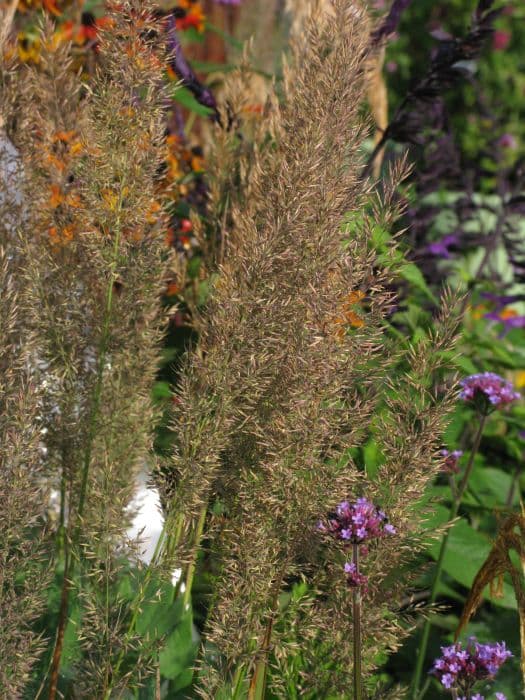Maiden grass Miscanthus sinensis 'Juli'











ABOUT
Miscanthus sinensis 'Juli', commonly known as Chinese silver grass or maiden grass, is a visually striking ornamental grass that features arching foliage and an elegant, fountain-like form. Its leaves are slender and elongated, with a lively green coloration that often showcases a silver midrib running down the center of each blade. As the seasons transition from late summer to fall, the foliage gradually transforms, adopting hues of yellow, orange, and sometimes red, adding a warm tone to the garden landscape. This variety of Chinese silver grass is noteworthy for its distinctive blooms. In late summer or early fall, it produces feathery flower plumes. These panicles are initially tinged with a soft pink or reddish color and are held high above the foliage on sturdy stems, adding a sense of airiness and verticality to the planting. As time passes, the plumes fade to a cream or silvery white, often persisting well into the winter months and providing visual interest during the colder season. The overall texture of Miscanthus sinensis 'Juli' is fine yet dense, creating a lush appearance in garden settings. Its graceful form and the movement it brings to the landscape as the leaves and plumes sway in the breeze make it a popular choice for gardeners seeking to add elegance and a naturalistic touch to their outdoor spaces. Despite the absence of specific dimensions, the plant displays a clumping habit and can act as a striking accent or a backdrop for other plants in mixed borders.
About this plant
 Names
NamesFamily
Poaceae
Synonyms
Maiden Grass, Eulalia, Chinese Silver Grass, Zebra Grass, Porcupine Grass
Common names
Miscanthus sinensis 'Juli'.
 Toxicity
ToxicityTo humans
Maiden grass, which is the common name of Miscanthus sinensis 'Juli', is not considered toxic to humans. There are no well-documented cases of poisoning from ingesting this plant. Consequently, ingestion is unlikely to cause harmful symptoms. However, as with any plant, individuals might experience different reactions, and it is generally advisable not to consume parts of ornamental plants due to possible unexpected adverse effects or individual sensitivities.
To pets
Maiden grass, also known as Miscanthus sinensis 'Juli', is generally not considered toxic to pets such as cats and dogs. There is no significant evidence that suggests this ornamental grass causes poisoning or adverse health effects when ingested by pets. While the plant is not expected to be poisonous, ingestion of plant material may lead to mild gastrointestinal upset in some pets due to the ingestion of non-digestible fibers, but no serious toxicity is anticipated.
 Characteristics
CharacteristicsLife cycle
Perennials
Foliage type
Deciduous
Color of leaves
Green
Flower color
Varies
Height
4 feet 6 inches (137 cm)
Spread
3 feet (91 cm)
Plant type
Grass
Hardiness zones
5
Native area
Asia
Benefits
 General Benefits
General Benefits- Ornamental Appeal: Miscanthus sinensis 'Juli', commonly known as Maiden Grass, has attractive foliage and plumes that add aesthetic value to gardens and landscapes.
- Drought Tolerance: Once established, Maiden Grass is quite drought-tolerant, requiring minimal watering in dry conditions.
- Adaptability: It can thrive in a variety of soil types, from sandy to clay, making it a versatile choice for different garden settings.
- Cold Hardy: Maiden Grass is capable of withstanding cold temperatures, making it suitable for growth in cooler climates.
- Low Maintenance: It requires little upkeep beyond annual pruning, making it a convenient option for gardeners of all skill levels.
- Erosion Control: The root system of Maiden Grass helps stabilize soil and prevent erosion on slopes or in areas prone to soil loss.
- Seasonal Interest: With its changing colors and textures through the seasons, Maiden Grass provides year-round interest in the landscape.
- Privacy Screen: When planted in groups, Maiden Grass can create natural, living screens that enhance privacy in outdoor spaces.
- Habitat Support: The grass provides shelter and food for wildlife, including birds and beneficial insects.
- Deer Resistant: Maiden Grass is generally not preferred by deer, making it a good option for areas where deer browse is a concern.
 Medical Properties
Medical PropertiesThis plant is not used for medical purposes.
 Air-purifying Qualities
Air-purifying QualitiesThis plant is not specifically known for air purifying qualities.
 Other Uses
Other Uses- Miscanthus sinensis 'Juli', commonly known as Chinese silvergrass, can be used as a natural sound barrier due to its dense growth habit, effectively reducing traffic noise when planted along roads or highways.
- The fibrous material from Chinese silvergrass can serve as a biodegradable alternative to plastic in producing pots for plant nurseries, aiding in reducing plastic waste.
- Chinese silvergrass can be used in crafting handmade paper, utilizing its fibrous stalks to create a textured, eco-friendly product.
- The plant can be woven into mats or screens, providing a sustainable material for garden privacy partitions or home decor.
- Chinese silvergrass used in a living snow fence can help in controlling snowdrift on roads during winter by reducing the amount of wind-transported snow reaching the roads.
- When dried, Chinese silvergrass can be used as thatching material for traditional or rustic roofing on garden structures or pavilions.
- In large-scale composting, the tough stalks of the plant can help to aerate the compost pile thus enhancing the decomposition process.
- Due to its high silica content, ash from burned Chinese silvergrass can be used in making natural soaps and detergents as a mild abrasive agent.
- Chinese silvergrass can be incorporated into floral arrangements and wreaths due to its attractive feathery plumes and long-lasting dried form.
- The plant's dense root system can be employed in erosion control, as it stabilizes soil on slopes and riverbanks, reducing the risk of soil erosion by wind and water.
Interesting Facts
 Feng Shui
Feng ShuiThe Maiden Grass is not used in Feng Shui practice.
 Zodiac Sign Compitability
Zodiac Sign CompitabilityThe Maiden Grass is not used in astrology practice.
 Plant Symbolism
Plant Symbolism- Adaptability: Miscanthus sinensis, commonly known as Chinese Silver Grass, is known for its adaptability to various climates and conditions, symbolizing the ability to thrive through change.
- Resilience: The tenacity of the Chinese Silver Grass to grow in different soil types and its resistance to pests and diseases illustrate resilience and endurance through difficulties.
- Beauty: With its elegant plumes and graceful foliage, Chinese Silver Grass is a symbol of beauty and grace in the natural world, often used in ornamental gardens to enhance aesthetic appeal.
- Privacy: As the Chinese Silver Grass can grow tall and dense, it is often used as a living screen, symbolizing the desire for privacy or creating one's own secluded sanctuary.
- Growth: The fast-growing nature of the Chinese Silver Grass mirrors the concept of rapid growth, progression, and development in life.
 Water
WaterMaiden Grass should be watered deeply once a week, ensuring the soil becomes moist but not waterlogged. It may require more frequent watering during periods of extreme heat or drought, potentially twice a week. Allow the top inch of soil to dry out between waterings to encourage healthy root growth. Expect to use approximately 1 to 1.5 gallons of water per plant for each watering session, depending on the size of the plant and environmental conditions.
 Light
LightMaiden Grass thrives in full sun conditions, requiring at least 6 hours of direct sunlight a day. The plant will achieve its best growth and flowering when placed in an area with unobstructed access to sunlight. Avoid heavily shaded areas, as insufficient light can lead to poor growth and fewer plumes.
 Temperature
TemperatureMaiden Grass is hardy and can tolerate a wide temperature range, surviving in temperatures as low as -20°F and as high as 90°F. However, it grows best in temperatures between 50°F and 75°F. It's essential to plant it in an area that doesn't experience frequent temperature fluctuations beyond these extremes.
 Pruning
PruningPrune Maiden Grass in late winter or early spring before new growth starts. This encourages healthy new shoots and maintains an attractive shape. Typically, the plant is cut back to about 4 inches above ground level. Pruning once a year is sufficient, and the best time is just before the last frost when the plant is still dormant.
 Cleaning
CleaningAs needed
 Soil
SoilMaiden Grass requires well-draining soil with a pH of 5.5 to 7.5; mix loam with compost and sand to improve drainage.
 Repotting
RepottingMaiden Grass is a perennial grass and does not require frequent repotting; it may be divided every few years for propagation.
 Humidity & Misting
Humidity & MistingMaiden Grass tolerates a wide range of humidity levels but prefers average outdoor conditions.
 Suitable locations
Suitable locationsIndoor
Provide full sun, limit pot size, don't overwater.
Outdoor
Full sun, well-drained soil, space clumps 3-6 feet apart.
Hardiness zone
4-9 USDA
 Life cycle
Life cycleChinese silver grass 'Juli' typically starts its life cycle with the germination of seeds, which requires a combination of warm temperatures and moist soil conditions. Once germinated, the young seedlings establish roots and shoots, growing rapidly during the spring and summer months due to their preference for full sunlight and well-draining soil. As the plant matures, it forms tall, erect stems with arching leaves and feathery flower plumes that usually appear in late summer to fall, providing visual interest and attracting pollinators. Following pollination, seeds develop that can disperse to propagate new plants, though Miscanthus sinensis 'Juli' can also be propagated vegetatively through division of the root clumps usually during spring or early summer. During the winter, this perennial dies back to the ground, becoming dormant until the next growth cycle begins with warmer spring temperatures. Over several years, Chinese silver grass 'Juli' can form dense clumps, reaching up to 3 to 6 feet in height and spreading outwards, necessitating occasional division to manage its size and maintain vigor.
 Propogation
PropogationPropogation time
Spring-summer
Propogation: Miscanthus sinensis 'Juli', commonly known as Maiden Grass, is typically propagated in late winter to early spring before new growth begins. Division is the most popular method of propagation for this ornamental grass. To propagate by division, the gardener should carefully dig up an established clump of Maiden Grass and gently separate it into smaller sections, ensuring that each piece has a portion of the root system attached. These divisions can then be immediately replanted into the garden or into pots with well-draining soil, spacing them about 3 to 4 feet apart (about 0.9 to 1.2 meters) to accommodate their mature size. It's essential to water the new divisions thoroughly after planting to help establish the root system. This method of propagation is straightforward and allows gardeners to quickly expand their plantings or share with others.









